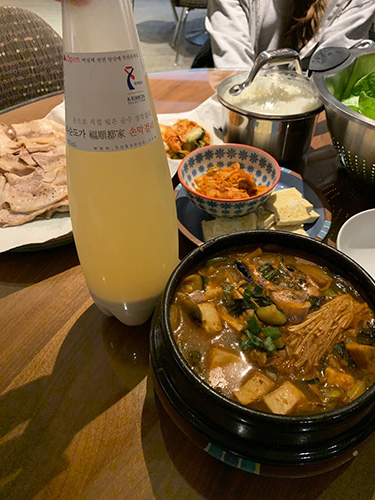Boksoondoga Makgeolli

My friend Sarah went to Korea and brought me a bottle of makgeolli made by Boksoondoga in Ulsan, Korea. I was very excited, because it’s impossible to find decent makgeolli in the States, which is the main reason why most of you have no clue what I’m talking about. Makgeolli is traditional alcoholic beverage from Korea made with rice. Good-quality makgeolli is unfiltered, so unlike most of alcoholic beverages, the liquid is cloudy. Makgeolli has low alcohol level, 3 to 9 percent, so all the unfiltered microbes can spoil it if not consumed within two to three months of bottling.
Knowing I’d have to act fast, I planned out the dinner for the makgeolli as soon as I received it. I had to make the dinner really count. Plus, it was a great excuse to invite my friends over for a traditional Korean dinner. Of course, everybody was interested — who would say no to alcohol and a free dinner? Some of my friends were coming all the way from Virginia. I filled the menu with my favorites: dwenjang jjigae (fermented soybean stew), fried tofu, fried kimchi, pork belly, and, of course, lots of white rice.
On the big night, with my cooking well under way, I turned to the makgeolli. The contents in the bottle were clearly separated out, with the sediments taking up a good quarter of the bottle. Sarah told me to open the bottle carefully: the carbonation in the bottle can cause the liquid to spray like a shaken-up bottle of Coke. I wasn’t sure how to mix the solids with the liquid but soon realized that the carbonation does the job automatically. When I finally opened the cap, the liquid, once clear, was cloudy and beige.
I’ve had imported makgeolli in the U.S. before, but it was kind of the Budweiser version: watery, sour, and kind of gross. Sad to say, but I was expecting something similar this time, but my friends and I were blown away by how good it was! I took a small sip and picked up on delicate notes of pear, red and green apple, and banana, along with a soft hint of rice hugging the fruit notes. What I loved most was the texture: The cloudiness lent a creamy mouthfeel, and the carbonation filled my mouth with tiny bubbles, leaving a refreshing aftertaste. It was sweet but not cloying. It was very well balanced with A light zing of sourness and carbonation. It was a light-hearted and fun drink. My friends, who all had makgeolli for the first time, said it reminded them of horchata and kombucha. I thought this description was right on! The color is similar to horchata, and it has similar texture and sweetness. Like kombucha, it has perkiness and fizz.
The dinner fell short of being perfect. I thought makgeolli should be paired with any traditional Korean food, and it did paired well. The soft texture and sweetness rounded out the salty and spicy food I prepared. Makgeolli bottle was emptied too quickly, and we were disappointed when we realized there were no pork belly left. But when I sent the picture of the dinner and makgeolli to my mom, all she could say was, “why didn’t you drink it with pajeon (scallion pancakes)?”. Next time, I should have my mom plan the menu for me!